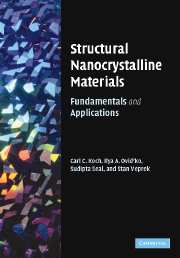Book contents
- Frontmatter
- Contents
- Preface
- Acknowledgments
- 1 Introduction
- 2 Processing of structural nanocrystalline materials
- 3 Stability of structural nanocrystalline materials – grain growth
- 4 Mechanical properties of structural nanocrystalline materials – experimental observations
- 5 Mechanical properties of structural nanocrystalline materials – theory and simulations
- 6 Corrosion of structural nanomaterials
- 7 Applications of structural nanomaterials
- Index
Preface
Published online by Cambridge University Press: 04 December 2009
- Frontmatter
- Contents
- Preface
- Acknowledgments
- 1 Introduction
- 2 Processing of structural nanocrystalline materials
- 3 Stability of structural nanocrystalline materials – grain growth
- 4 Mechanical properties of structural nanocrystalline materials – experimental observations
- 5 Mechanical properties of structural nanocrystalline materials – theory and simulations
- 6 Corrosion of structural nanomaterials
- 7 Applications of structural nanomaterials
- Index
Summary
Nanoscience and nanotechnology has become an identifiable, if very large, diverse, and multidisciplinary field of research and emerging applications. It is one of the most visible and growing research areas in science and technology. Government research funding agencies throughout the world have recognized its potential importance with substantial special initiatives to support its growth and development. The realms of nanotechnology applications are being explored not only of chemistry, materials, and engineering, but the frontiers of medicine as well. This on-going research is what enables the continuing expansions in nanotechnology. Over the past two decades there has been a revolution in the material-science field that has sparked great interest and research in all areas of science and engineering. Nanotechnology and nanoscience are leading this revolution fueled by the industrial progress, the scientific ability to fabricate, model and manipulate objects (things) with a small numbers of atoms, and the almost daily discovery of new phenomena of the nanoscale.
Nanostructured materials include atomic clusters, layered (lamellar) films, filamentary structures, and bulk nanostructured materials. The common thread to these various material forms is the nanoscale dimensionality, i.e. at least one dimension less than 100 nm (more typically less than 50 nm), often less than 10 nm. While this dimension requirement may appear to be arbitrary, it is usually at these length scales that the “physics” often changes and leads to very different properties, often superior, than those of conventional materials.
Information
- Type
- Chapter
- Information
- Structural Nanocrystalline MaterialsFundamentals and Applications, pp. ix - xiPublisher: Cambridge University PressPrint publication year: 2007
